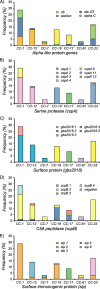Selection, recombination, and virulence gene diversity among group B streptococcal genotypes
- PMID: 19581371
- PMCID: PMC2725619
- DOI: 10.1128/JB.00369-09
Selection, recombination, and virulence gene diversity among group B streptococcal genotypes
Abstract
Transmission of group B Streptococcus (GBS) from mothers to neonates during childbirth is a leading cause of neonatal sepsis and meningitis. Although subtyping tools have identified specific GBS phylogenetic lineages that are important in neonatal disease, little is known about the genetic diversity of these lineages or the roles that recombination and selection play in the generation of emergent genotypes. Here, we examined genetic variation, selection, and recombination in seven multilocus sequence typing (MLST) loci from 94 invasive, colonizing, and bovine strains representing 38 GBS sequence types and performed DNA sequencing and PCR-based restriction fragment length polymorphism analysis of several putative virulence genes to identify gene content differences between genotypes. Despite the low level of diversity in the MLST loci, a neighbor net analysis revealed a variable range of genetic exchange among the seven clonal complexes (CCs) identified, suggesting that recombination is partly responsible for the diversity observed between genotypes. Recombination is also important for several virulence genes, as some gene alleles had evidence for lateral gene exchange across divergent genotypes. The CC-17 lineage, which is associated with neonatal disease, is relatively homogeneous and therefore appears to have diverged independently with an exclusive set of virulence characteristics. These data suggest that different GBS genetic backgrounds have distinct virulence gene profiles that may be important for disease pathogenesis. Such profiles could be used as markers for the rapid detection of strains with an increased propensity to cause neonatal disease and may be considered useful vaccine targets.
Figures



References
-
- Bisharat, N., N. Jones, D. Marchaim, C. Block, R. M. Harding, P. Yagupsky, T. Peto, and D. W. Crook. 2005. Population structure of group B Streptococcus from a low-incidence region for invasive neonatal disease. Microbiology 1511875-1881. - PubMed
-
- Bliss, S. J., S. D. Manning, P. Tallman, C. J. Baker, M. D. Pearlman, C. F. Marrs, and B. Foxman. 2002. Group B Streptococcus colonization in male and nonpregnant female university students: a cross-sectional prevalence study. Clin. Infect. Dis. 34184-190. - PubMed
-
- Blumberg, H. M., D. S. Stephens, C. Licitra, N. Pigott, R. Facklam, B. Swaminathan, and I. K. Wachsmuth. 1992. Molecular epidemiology of group B streptococcal infections: use of restriction endonuclease analysis of chromosomal DNA and DNA restriction fragment length polymorphisms of ribosomal RNA genes (ribotyping). J. Infect. Dis. 166574-579. - PubMed
Publication types
MeSH terms
Substances
Grants and funding
LinkOut - more resources
Full Text Sources
Molecular Biology Databases

